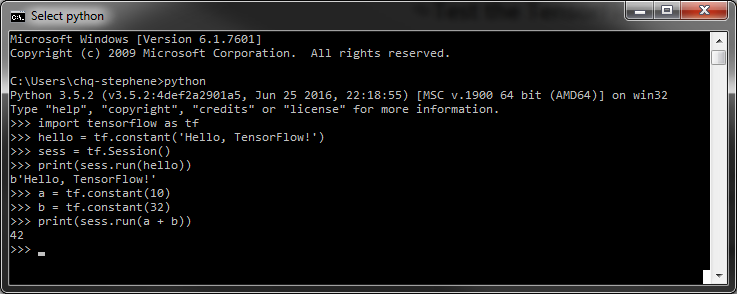

- ANACONDA INSTALL TENSORFLOW 2 FULL
- ANACONDA INSTALL TENSORFLOW 2 CODE
- ANACONDA INSTALL TENSORFLOW 2 DOWNLOAD
- ANACONDA INSTALL TENSORFLOW 2 WINDOWS
Note: All binaries distributed by Intel were built against the TensorFlow version tags in a centOS container with gcc 4.8.5 and glibc 2.17 with the following compiler flags (shown below as passed to bazel*) \-cxxopt=-D\_GLIBCXX\_USE\_CXX11\_ABI=0 -copt=-march=corei7-avx -copt=-mtune=core-avx-i -copt=-O3 -copt=-Wformat -copt=-Wformat-security -copt=-fstack-protector -copt=-fPIC -copt=-fpic -linkopt=-znoexecstack -linkopt=-zrelro -linkopt=-znow -linkopt=-fstack-protector Follow one of the installation procedures to get Intel-optimized TensorFlow. In case your anaconda channel is not the highest priority channel by default(or you are not sure), use the following command to make sure you get the right TensorFlow with Intel optimizationsīesides the install method described above, Intel Optimization for TensorFlow is distributed as wheels, docker images and conda package on Intel channel. Open Anaconda prompt and use the following instruction
ANACONDA INSTALL TENSORFLOW 2 DOWNLOAD
If you don't have conda package manager, download and install Anaconda Install the latest Intel® Optimization for TensorFlow* from Anaconda* CloudĪvailable for Linux*, Windows*, MacOS* OS Binaries Get Intel® Optimization for TensorFlow* Pre-Built Images

NOTE : Users can start with pip wheel installation from Intel Channel if no preference. It would show better performance in latest release than olders. NOTE: We recommend to use latest release of OS distributions to get better performance.
ANACONDA INSTALL TENSORFLOW 2 WINDOWS
It supports Windows Server 2016*, Windows Server 2019*, Windows 10*, Windows 11*. It supports most Linux distributions: like Ubuntu*, Red Hat Enterprise Linux*, SUSE Linux Enterprise Server*, Fedora*, CentOS*, Debian*, Amazon Linux 2*, WSL 2, Rocky Linux*, etc. There is a comparison table between those two releases in the additional information session. Since TensorFlow v2.9, the oneAPI Deep Neural Network Library (oneDNN) optimizations are enabled by default. The feature is off by default before v2.9, users can enable those CPU optimizations by setting the the environment variable TF_ENABLE_ONEDNN_OPTS=1 for the official x86-64 TensorFlow. The oneAPI Deep Neural Network Library (oneDNN) optimizations are also now available in the official x86-64 TensorFlow after v2.5.
ANACONDA INSTALL TENSORFLOW 2 CODE
Code samples to help get started with are available here. Download and Install to get separate conda environments optimized with Intel's latest AI accelerations. Now, Intel Optimization for Tensorflow is also available as part of Intel® AI Analytics Toolkit. This install guide features several methods to obtain Intel Optimized TensorFlow including off-the-shelf packages or building one from source that are conveniently categorized into Binaries, Docker Images, Build from Source.įor more details of those releases, users could check Release Notes of Intel Optimized TensorFlow. Starting from TensorFlow v1.9, Anaconda has and will continue to build TensorFlow using oneDNN primitives to deliver maximum performance in your CPU. For more information on the optimizations as well as performance data, see this blog post TensorFlow* Optimizations on Modern Intel® Architecture.Īnaconda* has now made it convenient for the AI community to enable high-performance-computing in TensorFlow.
ANACONDA INSTALL TENSORFLOW 2 FULL
In order to take full advantage of Intel® architecture and to extract maximum performance, the TensorFlow framework has been optimized using oneAPI Deep Neural Network Library (oneDNN) primitives, a popular performance library for deep learning applications. TensorFlow* is a widely-used machine learning framework in the deep learning arena, demanding efficient utilization of computational resources. But never use both of them within a virtual environment.Intel® Optimization for TensorFlow* Installation Guide Tips: After an env is activated, you can use pip or conda to install packages into it. # activate an env and install package into this very env It is always recommended to use a virtual environment while developing Python applications.Įxamples # create an virtual environment named py2 with Python 2.7 installed When you switch projects, you can simply create a new virtual environment and not have to worry about breaking the packages installed in the other environments. They essentially allow you to create a “virtual” isolated Python installation and install packages into that virtual installation. Venv (for Python 3) and virtualenv (for Python 2) allow you to manage separate package installations for different projects. conda is both a package manager and a environment manager. You should create different environments for different projects, which is a very basic function included in conda.


 0 kommentar(er)
0 kommentar(er)
